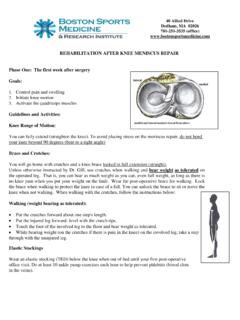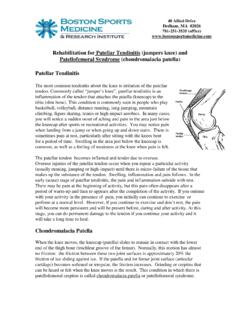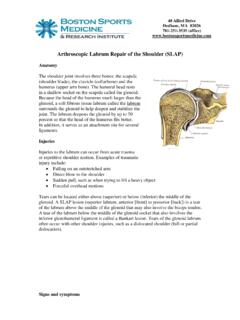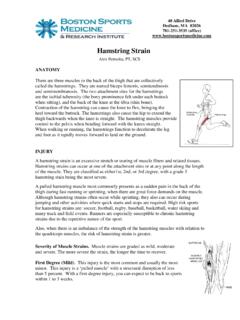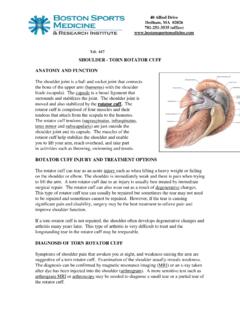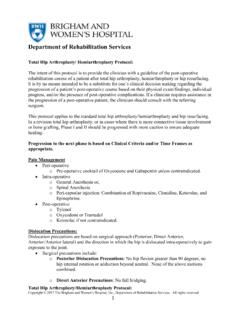Transcription of Achilles Tendon Repair Protocol - Boston Sports Medicine
1 Achilles Tendon RUPTURE ANATOMYThe Achilles Tendon is a strong Tendon that connects the calf muscles to the heel. The calf is formed by two muscles: the underlying soleus muscle and the thick outer gastrocnemius muscle. When they contract, they pull on the Achilles Tendon causing your foot to point down (plantar flexion)and helping you raise up on your toes. This powerful muscle group helps when you sprint, jump, or climb. With aging and overuse, the Achilles Tendon is subject to degeneration within the substance of the Tendon .
2 The term degeneration means that wear and tear occurs in the Tendon over time and leads to a weakening of the Tendon . Degeneration in a Tendon usually shows up as a loss of the normal arrangement of the fibers of the Tendon . Tendons are made up of strands of a material called collagen (think of a Tendon as similar to a nylon rope with the strands of collagen being the nylon strands). Some of the individual strands of the Tendon become jumbled due to the degeneration, other fibers break, and the Tendon loses strength. The healing process in the Tendon can cause the Tendon to become thickened as scar tissue tries to repairthe Tendon .
3 This process can continue to the extent that a nodule forms within the Tendon . This condition is called tendinosis. The area of tendinosis in the Tendon is weaker than normal Tendon and is usually painful. Spontaneous rupture of the Achilles Tendon can occur in patients in their third to fifth decade. Rupture is more common in men than women and most injuries occur during sporting activities. The most common mechanism of injury is pushing off forcefully such as in tennis, squash, racquetball and basketball. When the Achilles Tendon ruptures, the person often hears a "pop" or "snap" at the time of injury and feels a sudden pain in the region of the Achilles Tendon .
4 However,the pain subsides quickly. There is weakness when trying to stand on tip-toes. A defect or gap in the Achilles Tendon can usually be IMAGING X-rays are useful to rule out fractures, but are of limited value to diagnose Achilles Tendon ruptures. Although MRI will show the ruptured Tendon , it is usually not necessary to obtain an MRI because the diagnosis is obvious to OPTIONSNon- surgical Treatment 40 Allied DriveDedham, MA 02026781-251-3535 (office) the foot and ankle are immobilized in a cast with the toes pointing down for at least 8 weeks thetorn Achilles Tendon can heal. Non-surgical treatment avoids potential complications associated with surgery, such as infections and wound breakdown.
5 However, there is a higher re-rupture rate with cast treatment, there is less pushing-off strength and less endurance when compared to tendons that have been surgically Treatment Surgical Repair of Achilles Tendon ruptures consists of sewing together the torn ends. Sometimes, if the injury is chronic or the tissue is poor, local tissue such as Tendon grafts or fascia can be used to reinforce the Repair . A major advantage of early Repair is that early range of motion out of cast can be Repair of the Achilles Tendon offers a lower re-rupture rate (0-4%), a greater chance of returning to Sports , greater strength, and more endurance.
6 However wound complcations such as wound breakdown or infection can occur and can be very operative rehabilitation consists of a cast for two weeks, then a removable cast-boot for about 12 weeks after surgery. It usually takes six months after surgery before Sports activities canbe Tendon Repair SURGERY REHABILITATION Protocol PREOPERATIVE INSTRUCTIONSHere are guidelines that will help you in preparing for surgery to Repair your Achilles Tendon :BEFORE SURGERY:Dr. Gill will see you in the office. The doctor or his associate will do a preoperative history and physical examination and complete the necessary paperwork.
7 He will write preoperative hospital orders and order laboratory tests as needed. SEVERAL DAYS BEFORE SURGERY:Wash the leg and ankle several times a day to get it as clean as you can. This decreases the risk of careful not to get any scratches, cuts, sunburn, poison ivy, etc. The skin has to be in very good shape to prevent problems. You do not need to shave the DAY BEFORE SURGERY:Please contact Dr. Gill s office to get the exact time you should report to the hospital for surgery. You can have nothing to eat or drink after midnight on the evening before surgery. It is very important to havea completely empty stomach prior to surgery for anesthesia safety reasons.
8 If you have to take medication, you can take the medication with a sip of water early in the morning prior to surgery (but later tell the anesthesiologist you have done so).THE DAY OF SURGERY:Please arrive at the surgery center 2 hours prior to your scheduled operative time. Be sure to bring any crutches, braces, slings, ice machines or imaging studies that you have received. 40 Allied DriveDedham, MA 02026781-251-3535 (office) Tendon Repair SURGERYPOST OPERATIVE INSTRUCTIONSPHASE ONE: The first week after surgerySURGERY:After anesthesia has been given, your leg will be cleaned and sterile drapes will be placed.
9 A small incision will be made over the Achilles Tendon . The ruptured Tendon is identified and exposed. The ruptured ends of the Tendon are brought together with sutures to achieve a secure Repair . Sometimes a small Tendon in the leg is also used to reinforce the Achilles Tendon Repair . The skin is closed with sutures and the foot is immobilized in a cast. AFTER SURGERY:You will be given a prescription for pain medication to take home with you (usually Percocet, Vicadin, or Tylenol with codeine). The pain medication has a tendency to make you constipated and occasionally can cause addition to this medication you should take one aspirin a day to help prevent blood clots (phlebitis).
10 CAST/CRUTCHESYou will go home with a cast on your leg and foot. As much as possible, keep you foot elevated higher than your heart and move the toes up and down often to help control swelling. Use the crutches when you walk, but do not bear weight on your operated VISITP lease make an appointment to see Dr. Gill in the office one week after surgery. At that time your cast and sutures will be examined. Dr. Gill will give you further instructions at that Allied DriveDedham, MA 02026781-251-3535 (office) Tendon Repair SURGERYREHABILITATION PROTOCOLPHASE 2: Weeks 4 through 8 after surgeryGoals1. Protect the repaired tendon2.


